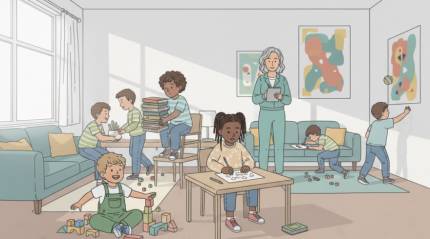Child ADHD Screening Questionnaires: A Complete Caregiver Guide
- 16 October 2025

What This Screening Tool Is and Why It Matters
Families often encounter screening questionnaires early in the journey of understanding attention, impulse control, and behavior patterns in a child. These forms organize observations from home and school, translating day-to-day behaviors into structured, comparable data. Because symptoms fluctuate with context, a standardized format helps clinicians see patterns that might otherwise be missed during a brief office visit.
Screening questionnaires are not the diagnosis itself; they are a lens that sharpens the view. The items typically mirror DSM-5 symptom clusters, covering inattentive and hyperactive-impulsive domains, while also checking for functional impact, such as difficulties with homework, friendships, or classroom routines. When multiple reporters contribute, parents, teachers, and sometimes the child consistency and discrepancies become informative signals rather than confusion.
These tools also support early identification. When school concerns surface, a quick, validated rating scale can guide whether to pursue a comprehensive evaluation or try classroom strategies first. Clinicians leverage longitudinal use to monitor change over time, offering a feedback loop on interventions like behavioral therapy, educational supports, or medication adjustments. Used well, a questionnaire acts as a bridge between lived experience and evidence-based care.
- Captures symptom frequency in real settings.
- Highlights impairment across academic, social, and home domains.
- Aggregates perspectives from different adults and environments.
- Supports ongoing monitoring of treatment response.
How Clinicians Use It During Evaluation
In a typical clinic flow, intake begins with history: perinatal factors, developmental milestones, sleep patterns, learning challenges, and family context. The clinician then requests rating forms from caregivers and teachers to quantify concerns. This step sparks a shared language one caregiver might see distractibility as occasional, while a teacher marks it as frequent, and the comparison sharpens next steps.
Standardized scoring converts raw checkmarks into norm-referenced metrics, allowing the provider to gauge severity against age-based expectations. In many pediatric visits, the pediatric ADHD questionnaire anchors the intake and feeds the conversation with concrete examples from multiple informants, while still leaving room for nuanced clinical judgment that integrates history and observation.
| Rater | Primary Domains | Typical Time | Practical Tip |
|---|---|---|---|
| Parent/Caregiver | Home routines, emotional regulation, sleep, chores | 8–12 minutes | Complete after a typical week to avoid bias from unusual days. |
| Teacher | Attention during instruction, seatwork, peer interactions | 7–10 minutes | Include comments about accommodations already tried. |
| Child (age-appropriate) | Self-awareness, motivation, internal distractions | 5–8 minutes | Provide a quiet space and clarify examples before starting. |
After collection, the clinician synthesizes questionnaire scores with interviews, school reports, and developmental testing if indicated. Context matters; anxiety, trauma, learning differences, or sleep disorders can mimic or amplify inattention and restlessness. The goal is a clear, compassionate plan that targets root causes and prioritizes function: academic progress, family harmony, and social connection.
- Use consistent raters over time to track progress accurately.
- Pair ratings with objective data like grades, work samples, and attendance.
- Reassess after meaningful changes in routine, supports, or treatment.
Benefits, Strengths, and Limitations
When thoughtfully deployed, screening questionnaires create momentum. They translate vague worries into measurable constructs, enabling shared decision-making. Because many instruments are validated, results come with reliability and normative context, helping clinicians interpret whether behaviors align with expectations for age and setting. Families appreciate the clarity: specific items point to concrete strategies, such as external reminders for forgetfulness or movement breaks for restlessness.
These tools also shine in progress monitoring. Over months, a clinician can see whether inattention ratings are trending downward with targeted supports, or whether hyperactivity remains elevated on days without structured routines. That longitudinal view supports fine-tuning of behavioral therapy, parent coaching, classroom accommodations, and medication dosing when appropriate. The feedback loop reduces guesswork and focuses on what actually moves the needle for a child.
Limitations deserve equal attention. Questionnaires are snapshots influenced by mood, stress, and cultural norms around behavior. Reporter bias can skew results, especially if forms are completed in a rush or during a crisis. Overlap with conditions like anxiety, dyslexia, autism spectrum traits, or sleep apnea can complicate interpretation. Strong practice includes triangulating ratings with interviews, direct observation, academic assessments, and medical evaluation when indicated. The tool is a compass, not a verdict.
- Strength: Validated structure increases confidence in results.
- Strength: Multi-informant ratings reveal cross-setting consistency.
- Limitation: Susceptible to context and rater bias.
- Limitation: Cannot substitute for a full clinical evaluation.
Preparing Your Family and Making Results Actionable
Preparation starts with routine. Choose an ordinary week to complete forms, and gather work samples, progress notes, and any behavior plans already in place. If possible, ask the child’s teacher about times of day when focus is strongest and weakest, and what supports help most. Share sleep patterns, screen habits, and nutrition changes, as these can meaningfully affect attention and behavior.
It also helps to define goals in plain language: fewer missing assignments, smoother mornings, or improved peer relationships. Before the appointment, many families assemble report cards, discipline records, and tutoring notes, which gives the clinician a realistic view of function and growth. During follow-up, clinicians may integrate findings from pediatric ADHD testing into a broader plan that includes parent training, executive function coaching, and school accommodations tailored through 504 or IEP processes.
Actionable planning means translating data into daily routines. If mornings are chaotic, introduce visual schedules and a staged backpack checklist. For homework hurdles, consider a distraction-reduced workspace, short work sprints with breaks, and clear start times anchored to household rhythms. Schedule exercise and fresh air, which can improve mood and readiness to learn. Revisit the plan after a few weeks with fresh ratings to see what is helping and where to pivot.
- Bring examples of completed and incomplete schoolwork to highlight patterns.
- Track sleep duration and quality for at least two weeks.
- Agree on 1–2 priority goals so interventions stay focused and feasible.
Faq: Practical Answers for Busy Caregivers
How accurate are these questionnaires?
They are dependable when used as intended: alongside interviews, school data, and medical context. Validated forms show good reliability, and scores align with functional concerns, especially when both home and school raters contribute. Accuracy improves with thoughtful completion and ordinary-week timing.
Do results mean my child must start medication?
No single tool dictates treatment. Clinicians consider impairment, age, coexisting conditions, family preferences, and school supports. Many children benefit first from behavioral strategies, environmental adjustments, and skill-building, with medication considered when impairment remains significant.
What if parent and teacher ratings disagree?
Differences are informative. They can reflect environmental structure, expectations, or stress levels. The clinician will explore why behavior looks different across settings and tailor strategies accordingly, sometimes adding direct observation or additional assessments.
How often should we repeat the forms?
Recheck after meaningful changes new classroom, fresh routines, therapy starts, or medication adjustments. In stable periods, quarterly or semiannual monitoring helps track trends without creating survey fatigue.
Can these tools identify other conditions?
They can flag areas needing exploration, such as anxiety symptoms or learning challenges, but they are not definitive for other diagnoses. If red flags emerge, the clinician may recommend targeted assessments, vision and hearing checks, or academic testing to clarify contributors.



